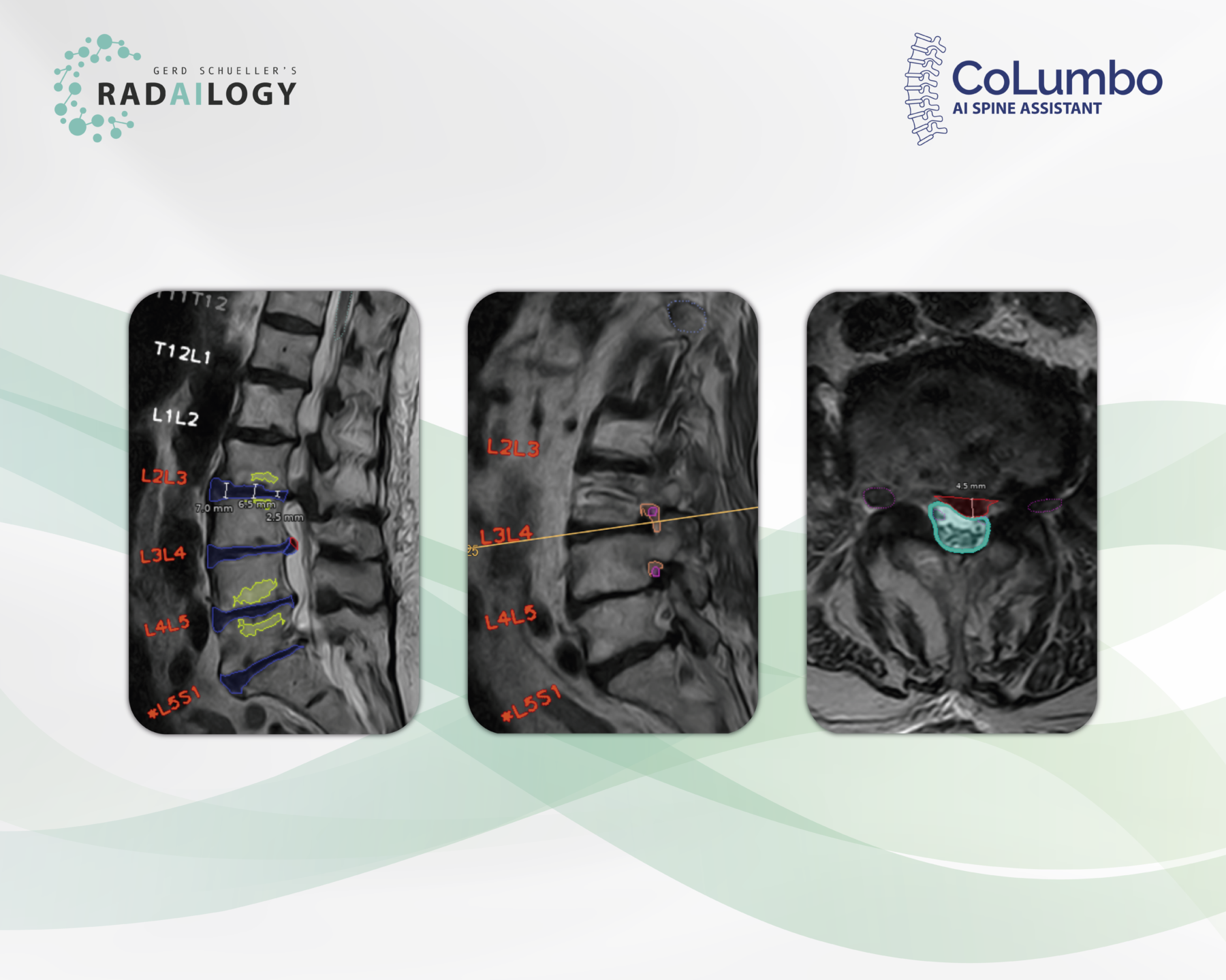T2 sagittal (left and middle) and T2 axial (right) MRI of the lumbar spine of a patient with back pain, lower limb weakness and paresthesia. Marked disc bulging (blue) and spinal canal stenosis at the level L2/L3, moderate disc bulging and spinal canal stenosis at the levels Th1-L2 and L4-S1. Left paramedian disc herniation (red), dural sac impingement (light blue) and recessal displacement of the left L4 nerve root at the level L3/L4. Foraminal stenosis and compression of the left foraminal nerves L3 and L4 (pink) at the levels L3-L5. Osteochondrosis Modic Type II at the levels L2/L3 and L4/L5.
With CoLumbo we have an excellent AI assistant for the assessment of the MRI of the lumbar spine. The latest release, now available on Radailogy, brings with it a variety of additional features for high-quality reporting of this common radiological examination. In particular, the description of foraminal stenoses and foraminal nerve impingement as well as the detection of osteochondrotic pathologies according to Modic are important.
It is with great pleasure that we present CoLumbo, an AI assistant for MRI of the lumbar spine.
Why CoLumbo is important and how it works
CoLumbo saves time and increases accuracy in the detection of the most common pathologies of the lumbar spine.
Lumbar spine MRI findings are reported and visualized. It assists in the knowledge transfer from radiologists to both patients and clinicians. In addition, all findings are written in comprehensive, standardized reports and can be used as an integral, automatically filling part of final documents.
Who benefits
Patients, clinicians, and radiologists by more detailed and more accurate diagnosis with subsequent decreased likelihood of suboptimal therapy or surgery. Accurate automatic measurements and clear colorful depiction reduce the need for measuring MRI findings by hand.
Our own experience at Radailogy
The AI assistant supports the detection of disc herniation, disc bulging, central spinal canal stenosis, foraminal stenosis, nerve root impingement, reduced vertebral and disc height, hypo- and hyperlordosis, spondylolisthesis and pseudolisthesis as well as osteochondrotic pathologies according to Modic.
The scientific evidence
CoLumbo´s performance has been tested in clinical research with excellent results in accuracy for intervertebral disc detection and labeling (100%), for the detection of disc herniation (87%; 95% CI: 0.84, 0.89), extrusion (86%; 95% CI: 0.84, 0.89), bulging (76%; 95% CI: 0.73, 0.78), spinal canal stenosis (98%; 95% CI: 0.97, 0.99), nerve root compression (91%; 95% CI: 0.89, 0.92), and spondylolisthesis (87.61%; 95% CI: 85.26, 89.21), respectively.
Lehnen NC, Haase R, JFaber J, Rüber T, Vatter H, Radbruch A, Schmee FC. Detection of Degenerative Changes on MR Images of the Lumbar Spine with a Convolutional Neural Network: A Feasibility Study. Diagnostics 2021; 19;11(5):902
Data to upload to Radailogy
1.0-3.0 Tesla, T2 axial and sagittal 2D and 3D, slice thickness 3.45-5 mm

